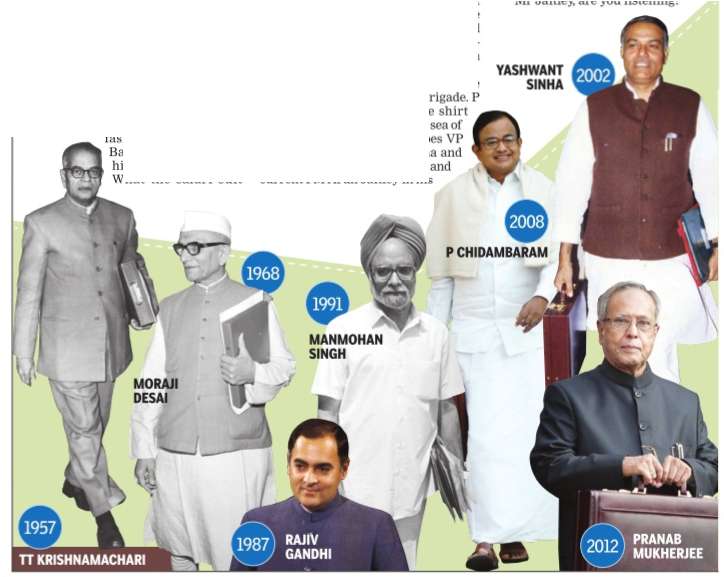Union budget speeches: India
This is a collection of articles archived for the excellence of their content.
|
Contents |
Finance Ministers (who presented Budgets)
1947-2014
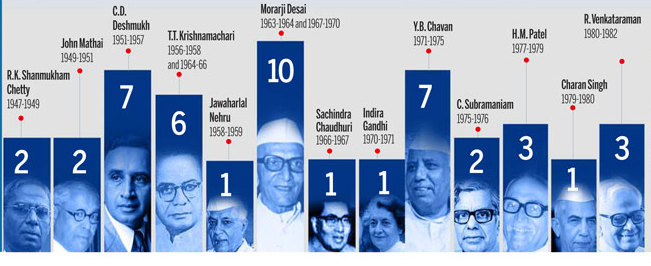
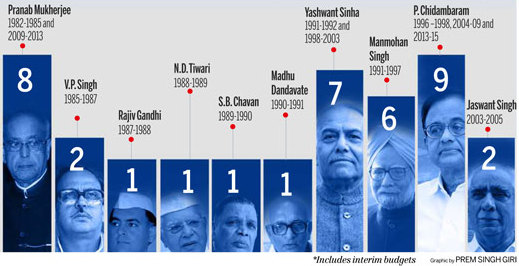
See the graphics, Leaders who decided our fiscal destiny, 1947-1982 and Leaders who decided our fiscal destiny, 1982-2005
In 67 years of Independence, 22 men and a woman laid out our fiscal destiny through 83 budget speeches. But some did it more than others. So who had the maximum say over the way we lived, worked and played?
Indpaedia’s note: Mr Arun Jaitley assumed charge as Finance Minister in mid-2015 and had, till Feb 2017, presented the 2016 and 2017 budgets, taking the total to 23 men and a woman.
Key words in Union budgets, 1947-
‘Women’
January 26, 2018:The Times of India
HIGHLIGHTS
The mention of 'women' as a word has been sparse in budget speeches over the years. The ghastly Nirbhaya gangrape case changed this trend in the 2013-14 budget. However, the initiatives launched in that budget have failed to take off
Beyond the obvious of economics and number crunching, the Union Budget is a good platform for the government to showcase its focus areas. The mention of the word 'women' in budget speeches since independence is a wonderful case study on the same. Women, as a word, was never really used in budget speeches until in 2008-09, when the then finance minister P Chidambaram mentioned it nine times. But for now, let us fast forward to December 16, 2012 -- when the ghastly Nirbhaya gang rape in Delhi's Munirka shook the nation.
A couple of months later, as Chidambaram, in his second stint as finance minister, read out the 2013-14 budget, the issue was still resonating and he mentioned 'women' as many as 24 times. Citing 'a collective responsibility to ensure the dignity and safety of women', he set up the 'Nirbhaya Fund', allocating Rs 1,000 crore. The Modi government too, since taking over in 2014, has been allocating an equal amount of sum in each budget. However, the apathy lies in the fact that neither of the governments have been able to actually spend the money. In fact, the schemes that the governments devised to use the fund, failed to even take off.
The sad state of affairs is not just confined to the 'Nirbhaya Fund'. In the same 2013-14 budget, the government proposed setting up of, in Chidambaram's words, 'India's first Women's Bank as a public sector bank'. The Bharatiya Mahila Bank- as it was christened, received an initial capital of Rs 1,000 crore and was inaugurated in November 2013 by then Prime Minister Manmohan Singh on the occasion of Indira Gandhi's birth anniversary. At its inception, the first CMD (Chairman and Managing Director) of the bank Usha Ananthasubramanian had said that the bank will emphasise on funding for women's skill development. The bank however failed to make much of a dent in the market as analysts suggested that other banks came up with the same model within their own business space. The fledgling state of the bank's fortune meant that the Modi government decided to merge it with the State Bank of India (SBI) last year.
Words that indicated shifting priorities, 1947-2017
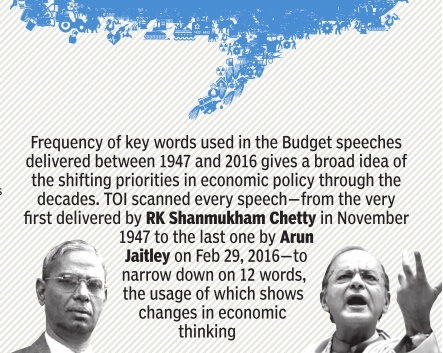
The Times of India

The Times of India

The Times of India
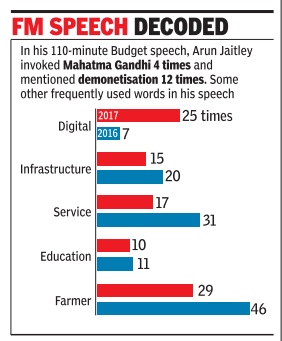
The Times of India
See four graphics. The first three are captioned
The frequency of key words used in Budget speeches (1947-2016) that reveal shifting priorities in economic policy and the fourth
Words used most frequently by Arun Jaitley in his Budget speeches of 2016 and 2017
Prime Minister’s speech
2018: a first
February 2, 2018: The Times of India
February 1, 2018 saw two Budget speeches being delivered. Just after the finance minister had finished speaking in Lok Sabha, PM Narendra Modi delivered a speech on TV to outline the benefits and the vision of the Budget, an exercise that looked like the sounding of the poll bugle.
Unlike the customary post-Budget remarks of his predecessors as well as his own on the last three occasions, the PM spoke for a good 25 minutes, this time detailing provisions of the Budget: an effort which while underlining his imprint on the exercise also reinforced speculation that the government from now on would be in full poll mode with the budget as one of the battle cries. “This Budget strengthens the foundation stone of ‘New India’ with a focus on agriculture to infrastructure. It covers aspects such as health plans for the poor and middle class and it has plans to increase the wealth of small entrepreneurs,” Modi said.
Modi said the emphasis of his government’s last full-year Budget ran from food processing and fibre optics to road and shipping and from rural India to ‘Ayushman India’ and Digital India to Startup India while also addressing the concerns of the youth, senior citizens and women.
The PM invoked the aspirational element of the Budget and promised to boost growth and jobs. “Ease of doing business as well as ease of living are in focus in this Budget. More savings for the middle class, new generation infrastructure for 21st century India and better health assurance — all are concrete steps towards ease of living,” Modi said. Like the FM Modi, too, made a detailed mention about how the Budget was farmer-friendly.
“I appreciate the decision to provide for one-and-a-half times’ remunerative price for the cost incurred by farmers. The Centre will put in place a sound system in consultation with states to ensure that farmers can avail the full benefits of this decision,” he said.
Sidelights
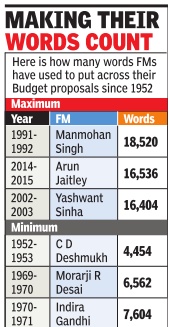
A BRIEF CASE FOR BUDGET TRAVELLERS
The Times of India Jul 11 2014
Longest speech
The record for the longest Budget speech-is held by an NDA FM, Jaswant Singh, who clocked 2 hours, 13 minutes in 2003.
Excluding a four-minute break, in 2014, FM Arun Jaitley spoke for 2 hours, 10 minutes.
Interim budget speeches’ length: 2014, 19
Took twice as long as PC’s 2014 speech, February 2, 2019: The Times of India
The last Interim Budget, which P Chidambaram presented in 2014 for UPA-II, lasted 55 minutes. At 105 minutes, Goyal’s took almost double the time, rivalling many full-fledged budgets in the past. Tax proposals have by convention not been announced in interim budgets, but Goyal argued that taxpayers need certainty at the beginning of the year to plan their finances. NDA MPs broke into sustained thumping and “Modi, Modi” chants the moment the tax rebate of up to Rs 5 lakh was announced.
References to self
New FM scores 204 but lags behind PC in `I'-Q Arun Jaitley spoke over 16,000 words in his speech, of which `I' figured 204 times, shows an analysis of his speech using online tool WriteWords. Every 81st word Jaitley used was an `I'. But the FM with the highest `I'-Q was P Chidambaram who is first, second, third, fourth and fifth in the list of FMs fond of the first person singular. According to an analysis of 67 previous Budgets (not including interim ones), Chidambaram used `I' with the highest frequency in 2013-14 ¬ once every 55 words.
This frequency was lower in Chidambaram's earlier stints as FM, but not by a wide margin. In 2005, 2007 and 2008, he used `I' once every 59 words. His 1997 speech was more modest, but by only one word. Jaitley actually comes a distant 19th in this list of 67 speeches.
The rather self-effacing Manmohan Singh used `I' only once every 87 words in his landmark 1991 Budget. But the least I-inclined of all FMs was Jawaharlal Nehru ¬ he used `I' only once every 276 words.
Fashion statements
The Times of India Feb 27 2015
Nandini Sengupta
With his bow tie, dark suit, fob chain and sideburns, James Wilson looked every inch the Victorian gentleman when he presented India's first budget on April 7, 1860 in London. His wardrobe became a template for many other FMs. Sir R K Shanmukham Chetty presented Independent India's first budget in an elegant suit on November 26, 1947.John Mathai, who laid down the roadmap for the Planning Commission on February 28, 1950, was even nattier in a three-piece. But the suit was soon ousted by the now Indian menswear classic -the bandhgala. TT Krishnamachari wore a grey one in 1957, Morarji Desai did a pin-striped version in 1968, and Rajiv Gandhi looked smart in a blue grey bandhgala in 1987. More recently Manmohan Singh in the 90s, Yashwant Sinha in the noughties and Pranab Mukherjee in 2012 have all gone for this chic staple.
Of course there have been notable exceptions to the bandhgala brigade like P Chidambaram in crisp white shirt and veshti and VP Singh in his sherwani.In his last outing, FM Arun Jaitley opted for the Nehru jacket. Will he be making a style statement this B-day?
The evolution of budget power dressing
Feb 27 2015
Nandini Sengupta
Independent India's first budget was presented by R K Shanmukham Chetty in elegant pinstripes at 5 pm on November 26, 1947. John Mathai, who presented the budget that laid down the roadmap for the Planning Commission on February 28, 1950, wore a three-piece grey suit with tie for the big B-day .
But the suit's popularity soon waned, and it was replaced in budgetday wardrobes by the reigning king of Indian men's formal wear -the bandhgala.
Tiruvellore Thattai Krishnamachari wore a grey one to present the budget on May 15, 1957; Morarji Desai wore a pin-striped one on February 29, 1968 and Rajiv Gandhi looked dashing in a blue grey bandhgala on February 28, 1987.More recently Manmohan Singh in the 90s, Yashwant Sinha in the noughties and Pranab Mukherjee in 2012 have all gone for this `national costume'. “It's the male counterpart of the sari, it spells powerful, formal and safe,“ says fashion designer Rohit Bal. “It's elegant and hides flaws beautifully.
What the safari suit used to be in the 70s and 80s, the bandhgala is now. It's a power staple.“
What works in its favour is its versatility and global appeal. It's easy to embellish a bandhgala and many FMs have done so, sometimes with a pocket square a la CD Deshmukh in the early 50s or with a fob chain which has been Pranab Mukherjee's style contribution in recent years. Says fashion designer Ra ghavendra Rathore: “The bandhgala is a representation of the most classic look of Indian menswear tailoring, so classic that it has now been globally accepted as a staple for any gentleman's wardrobe. The formality that it exudes is crisp and to the point, like the budget that is being delivered. Inspired by the `royal court prince jacket', it has evolved systematically to compete with its counterpart -the two button formal western suit,“ he adds.
Of course there have been notable exceptions to the bandhgala brigade. P Chidambaram in crisp white shirt and veshti stands out among a sea of budget-day bandhgalas. As does VP Singh in his sherwani, pyjama and cap. Others like Jaswant Singh and current FM Arun Jaitley in his last outing opted for the Nehru jacket while Indira Gandhi, the only woman finance minister to present a budget on February 28, 1970, wore a silk sari and grey shawl for the occasion. Interestingly, although a staple for the political classes, the Gandhi cap has not been ubiquitous to budget-day wardrobes.
Among the few who patronized it were Morarji Desai and YB Chavan.
So what should new-age FMs wear on the national day of number crunching in the years ahead? “A well-cut Jodhpuri bandhgala teamed with pants and a subtle pocket scarf to complete the well-groomed dapper look,” says Rathore. “The bandhgala jacket has always been worn with all its buttons closed, giving it an extremely formal feel. However, the next generation of politicians could leave the first two buttons open and wear a charming pocket scarf.” Fellow designer Rohit Bal talks of embellishments like “embroidery on the collar, buttons or even a brooch” to cut through the overwhelming formality of the occasion.
Poetry
Kashmir to Kanyakumari, FMs show off their verse-tality, February 2, 2020: The Times of India
The use of poetry was hardly unusual. After all, all finance ministers have done so, from Manmohan Singh, P Chidambaram to Arun Jaitley.
But Nirmala Sitharaman’s choice had a political right to it. She read out a verse in Kashmiri, with a few voices from the opposition immediately shouting about the region’s lockdown. They had not heard the finance minister fully, as she translated a key sentence about the lotus blooming in the Dal lake. Sitharaman chose Dinanath Koul’s evocative poem, Myon Vatan. Koul, who used the pen name Nadim, was a Sahitya Akademi recipient. “Our country is like Shalimar Bagh, our country is like the lotus in the Dal Lake, our country is like the warm blood of the youth, my country, your country, our country, the most adorable country in the world.”
At a time when Jammu and Kashmir has been denuded of its special status, the poem was redolent with political meaning. And the lotus simile brought smiles on the faces of the BJP leaders as the opposition fell silent. Manmohan Singh, who had a flair for Urdu poetry, cited Allama Iqbal and Muzaffar Razmi Kairanvi. P Chidambaram regularly referred to ancient Tamil poet Thiruvalluvar, as did Sitharaman incidentally. Yashwant Sinha and Arun Jaitley also freely quoted verse.
The sunny yellow silk sari complemented Sitharaman’s allusion to the bouquet of flowers that comprised the three broad themes of the Budget — Aspirational India, economic development and Caring India.
Dressed in tune with the festive spirit of Basant Panchami, Sitharaman went on for long without a sip of water, a decision that left her feeling dehydrated. With two pages to go, she said the speech be considered tabled.
The FM balanced politics and fiscal policies, while the opposition protested against Sitharaman’s claim of government’s commitment to “happiness, safety and security” of every Indian, disrupting her address with reference to MoS finance Anurag Thakur’s controversial “goli maaro” speech. Loud protests, led by Trinamool MP Kalyan Banerjee who is blessed with strong lung power, erupted when the FM announced the government decision to disinvest a part of its stake in Life Insurance Corporation.
Sitharaman tapped into a couple of more poets. Classical Sanskrit poet Kalidas was quoted to convey how a just and generous ruler collects drops and gives back copiously. “They collect only for people’s wellbeing” said the ancient work Raghuvamsa. She also dipped into Tamil woman saint poet Aauvaiyar to quote “BhumitiruthiUnn” — “first tend to till one's land and then eat”.
Tulsidas, Amir Khusro, Rabindranath Tagore, Bharathiyar, Ramdhari Singh Dinkar, Mirza Ghalib, Rahat Indori, Bashir Badr and Dushyant Kumar were all heard in Lok Sabha in the winter and budget sessions in 2019.
